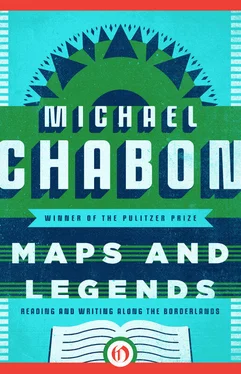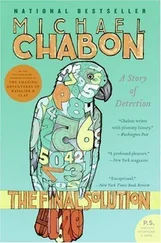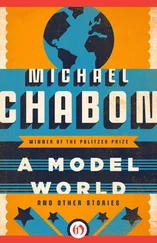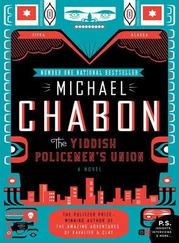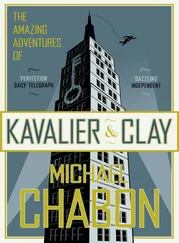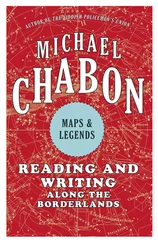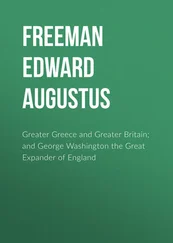It was not about escape, I wanted to tell Mr. Spector, thus unwittingly plagiarizing in advance the well-known formula of a (fictitious) pioneer and theorist of superhero comics, Sam Clay. It was about transformation.
And the Secret Anxiety of Origin
It is commonplace to assert the heritage of the costumed heroes of comic books in the misty mythosphere of the ancient world, and it’s tempting to view accounts of superhero origins, the sine qua non of the superhero narrative, as proof of that legendary inheritance.* Hyperbolic myths of origin have from the earliest times served to lend a paradoxical plausibility to the biographies of heroes. Baskets found floating in the bullrushes, oracle-doomed infants abandoned on hillsides, babies born with hammers in their hands. Traditional origin myths affirm the constant, even prenatal, presence of the marvelous in the hero’s life, of a vein of wonder that marbles it from one end to the other like the words embedded in a
* So indispensable is the origin story that Steve Gerber created one of the most radical and disturbing Marvel heroes of the 1970s, Omega the Unknown, simply by refusing ever to provide one.
Stick of Brighton Rock
But apart from a marked tendency toward orphanhood, the superhero generally disappoints the expectations of mythology. The costumed hero — if not a mutant — is born powerless and unheralded like the rest of us.* It takes the bite of a radioactive spider, or some other form of half-disaster (a lab explosion, a brutal act of street violence, a secret government experiment, an emergency transfusion of mongoose blood), to give birth to the hero, who then springs, full-grown like Athena, from the prized-open cranium of everyday life. The superhero works long hours at a day job (even that playboy Bruce Wayne puts in an awful lot of time at the office) and struggles in every way — legally, socially, emotionally — to fit in to the expectations of the quotidian world. The superhero in general has no overt or obligatory sense of destiny, none of the lust for glory and fame and treasure that characterize the classical hero.† Superheroes spend a lot of time wishing they could just stay home, spend time with their families and loved ones, date the girl they love, be like everybody else. They excel because they cannot help it, or because it would be wrong not to, or because they need to prove their worth, or to exonerate themselves, or to repay the debt they feel to society, their parents, the wizard in a subway tunnel who endowed them with magic might. Above all, superheroes have secret identities; they have lives and natures that their pursuit of heroism obliges them to conceal, to downplay, to deny. They cannot engage in the boastful trumpeting of one’s name and parentage so beloved among traditional heroes.
It is for this reason, and not out of their legendary heritage in the mythosphere, that comic books, the bastard child of newspaper strips and pulp magazines, have always displayed an arriviste fixation on questions and mysteries of origin. The superhero is a parvenu in the house of adventure, an immigrant on the shores of myth.
This general fixation with the origin story‡ goes beyond the particulars of Kryptonian birth or gamma-ray exposure to encompass the origin of the idea of the costumed superhero itself. Fans and historians of comic books (those synonymous creatures) have devoted loving years and pages in the thousands to isolating with some kind of precision the moment and the conditions that led to the birth of the costumed hero. And when they faltered in their efforts, in have strode the psychologists, the critics, the analysts, and, with mixed results, the comic-book writers and artists themselves.
The comic book preexisted the superhero, but so barely and with so little distinction that the medium has seemed indistinguishable in the cultural mind from its first stroke of brilliance. There were costumed crime fighters before Superman (the Phantom, Zorro), but only as there were pop quartets before the Beatles. Superman invented and exhausted his genre in a single bound. All the tropes, all the clichés and conventions, all the possibilities, all the longings and wishes and neuroses that have driven and fed and burdened the superhero comic over the past seventy years were implied by and contained within that little red rocket ship hurtling toward Earth. That moment — Krypton exploding, Action Comics No. 1—is generally seen to be Minute Zero of the superhero idea.
About the reasons for the arrival of Superman at that zero moment there is less agreement. In the theories of origin put forward by fans, critics, and other origin-obsessives, the idea of Superman has been accounted the offspring or recapitulation, in no particular order, of Friedrich Nietzsche, of Philip Wylie (in his novel Gladiator), of the strengths, frailties, and neuroses of Jerry Siegel and Joe Shuster, of the aching wishfulness of the Great Depression, of the (Jewish) immigrant experience, of the mastermind stratagems of popular texts in their sinister quest for reader domination, of repressed oedipal fantasies, of fascism, of capitalism, of the production modes of mass culture (and not in a good way), of celebrated strongmen and proponents of physical culture such as Eugen Sandow, and of a host of literary not-quite-Supermans (chief among them Doc Savage) who preceded him.
Most of these rationales of origin depend, to some extent, on history; they index the advent of Superman in mid-1938 to various intellectual, social, and economic trends of the Depression years, to the influence or aura of contemporary celebrities and authors, to the structure and demands of magazine publishing and distribution, et cetera. To suit my purpose here I might construct a similar etiology of the superhero costume, making due reference, say, to professional wrestling and circus attire of the early twentieth century, to the boots-cloak-and-tights ensembles worn by swashbucklers and cavaliers in stage plays and Hollywood films, to contemporary men’s athletic wear with its unitard construction and belted trunks, to the designs of Alex Raymond and Hal Foster and the amazing pulp-magazine cover artist Frank R. Paul. I could cite the influence of Deco and Streamline design aesthetics, with their roots in fantasies of power, speed, and flight, or posit the costume as a kind of fashion alter ego of the heavy, boxy profile of men’s clothing at the time.
Thus while claiming, on the one hand, a dubiously ahistorical, archetypical source for the superhero idea in the Jungian vastness of legend, we dissolve its true universality in a foaming bath of periodized explanations, and render the superhero and his costume a time-fixed idea that is always already going out of fashion. When in fact the point of origin is not a date or a theory or a conjunction of cultural trends but a story, the intersection of a wish and the tip of a pencil.
* In this regard he or she is closer kin to the giant-killing clever fools and brave tailors of folklore than to Hercules or Samson.
† This kind of thinking is typically more in the line of the super-villain, in fact.
‡ A fixation that helps explain the disproportionately high price among collectors of number-one issues and renders tedious the first acts of superhero film adaptations.
A Faithful Scale Model of Nothing
Now the time has come to propose, or confront, a fundamental truth: like the being who wears it, the superhero costume is, by definition, an impossible object. It cannot exist. One may easily find suggestive evidence for this assertion at any large comic-book convention by studying the spectacle of the brave and bold convention attendees, those members of the general comics-fan public who show up in costume and go shpatziring around the ballrooms and exhibition halls dressed as Wolverine, say, or the Joker’s main squeeze, Harley Quinn. Without exception, even the most splendid of these getups is at best a disappointment. Every seam, every cobweb strand of duct-tape gum, every laddered fishnet stocking or visible ridge of underpants elastic — every stray mark, pulled thread, speck of dust — acts to spoil what is instantly revealed to have been, all along, an illusion.
Читать дальше
Конец ознакомительного отрывка
Купить книгу
